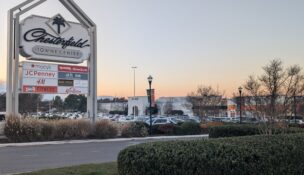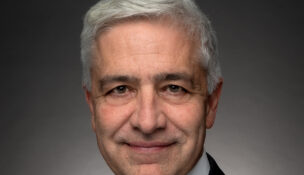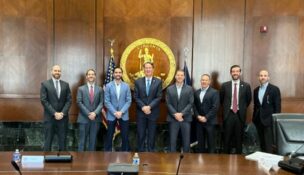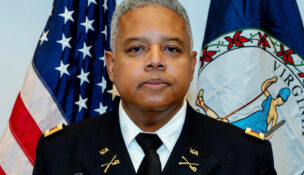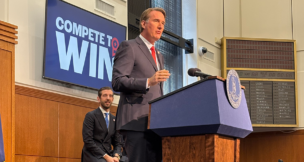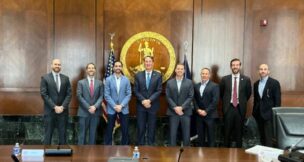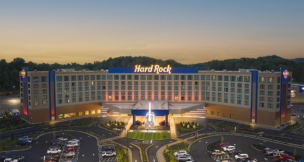Spanberger, Earle-Sears speak on right-to-work, talent pipelines
Virginia governor candidates have more similarities than in other issues
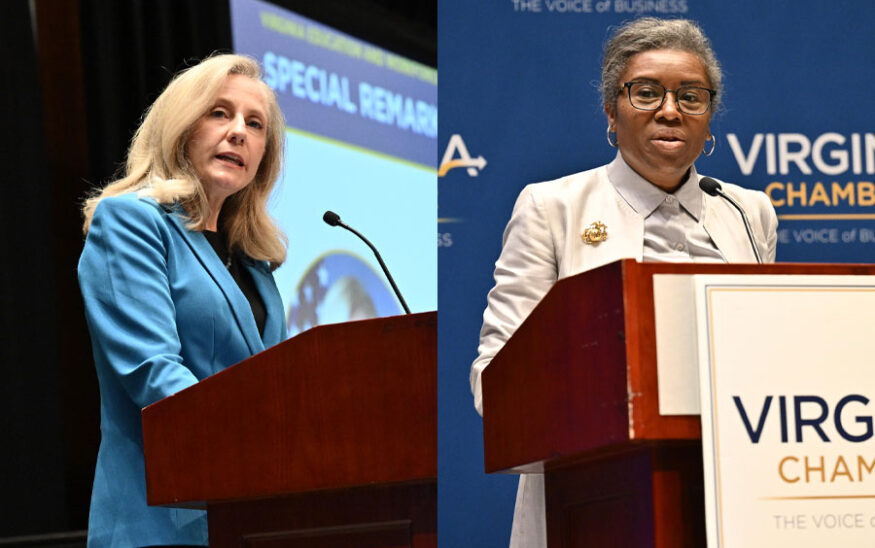
Virginia Democratic candidate former U.S. House Rep. Abigail Spanberger (L) and Republican candidate Lt. Gov. Winsome Earle-Sears separately addressed the Virginia Education and Workforce Conference on Oct. 14, 2025. Photos courtesy Virginia Chamber.

Virginia Democratic candidate former U.S. House Rep. Abigail Spanberger (L) and Republican candidate Lt. Gov. Winsome Earle-Sears separately addressed the Virginia Education and Workforce Conference on Oct. 14, 2025. Photos courtesy Virginia Chamber.
Spanberger, Earle-Sears speak on right-to-work, talent pipelines
Virginia governor candidates have more similarities than in other issues
SUMMARY:
- Virginia gubernatorial candidates delivered speeches at state chamber conference
- Spanberger said Virginia needs to top CNBC’s business-friendly state rankings again; Earle-Sears touts Youngkin administration’s achievements
- Earle-Sears says Spanberger’s record on right-to-work legislation differs from rhetoric
- Spanberger focuses on federal job layoffs hurting Virginians
Following a fiery debate last week, Virginia’s gubernatorial candidates discussed business and how to strengthen the state’s workforce pipeline at a Richmond conference hosted by the Virginia Chamber Foundation on Tuesday.
Speaking a few hours apart at the 2025 Virginia Education and Workforce Conference, former U.S. Rep. Abigail Spanberger, the Democratic candidate, outlined her agenda to strengthen Virginia’s educated workforce, while Republican candidate Lt. Gov. Winsome Earle-Sears highlighted her background and achievements of Gov. Glenn Youngkin.
While both said Virginia has a competitive workforce — Earle-Sears said the current gubernatorial administration had made Virginia the No. 1 state for workforce training and teacher excellence without specifying the ranking organization, while Spanberger cited CNBC ranking Virginia first for education this year — Spanberger pointed out that Virginia dropped from No. 1 in 2024 to No. 4 this year in CNBC’s Top States for Business ranking.
“In that ranking, they were clear about one major factor: Federal job cuts are disproportionately impacting Virginia’s economy,” Spanberger said. “And the chaos coming out of Washington isn’t just bad policy; it is creating real harm for Virginia families and businesses.”
When CNBC released the Top States rankings in July, the network said of Virginia, “All that business might is no match for the mighty budget cuts coming from across the Potomac, not to mention the tariffs.”
Federal job cuts also affect Virginians in manufacturing, food service and contracting, Spanberger added. “We need real plans to support displaced workers, attract new investment and show businesses and talent that Virginia is a reliable place to build a career and a company.”
Earle-Sears, however, never mentioned in her speech the federal administration’s job cuts or the current government shutdown, during which President Donald Trump has said furloughed federal workers may not receive back pay, and Office of Management and Budget Director Russ Vought has started mass layoffs — actions that Democrats have blasted and that federal workers’ unions have sued to prevent.
Instead, the lieutenant governor touted the accomplishments of Youngkin’s administration, saying that it had helped create 265,000 jobs since 2022, as well as providing $9 billion in tax relief, reducing or streamlining more than 100,000 regulations, and securing $140 billion in business investments.
Earle-Sears added that Virginia has to maintain its domestic and international competitive advantages, especially as China continues to make advances in engineering and manufacturing.
Right-to-work
Both candidates spoke about maintaining Virginia’s status as a right-to-work state, a view shared by many local and state chamber officials.
“I’ve said it before, and I will say it again: As governor, I will not sign a bill that repeals Virginia status as a right-to-work state,” Spanberger said in her morning address. “But let me also say this: I believe that we can do more to support working people, both in the business community and at the state level.”
Supporting working people would include establishing statewide paid and family medical leave, increasing the supply of affordable housing and child care, and raising the minimum wage, she said.
In her early afternoon speech, Earle-Sears said: “Right to work is an issue for me about liberty and about freedom. I will always defend Virginia’s right to work. It’s not an abstract policy to me.”
Earle-Sears also brought in Spanberger’s congressional record, saying, “By contrast, my opponent says one thing, when we know for a fact she not only co-sponsored the legislation to get rid of right to work, but she voted to get rid of it as well,”
Spanberger voted for the Protecting the Right to Organize Act of 2021, which passed the House but not the Senate. The act would have expanded protections for employees to organize and collectively bargain.
The lieutenant governor also said that Spanberger has received more than $1.4 million in donations from labor unions, while she has received none. According to the Virginia Public Access Project, Spanberger’s gubernatorial campaign has received $1.31 million from organized labor, receiving $500,000 from the American Federation of Teachers.
“I know there are those who think you can be pro-business or pro-worker, and I wouldn’t be surprised if there’s some people in this room that hold that opinion, but I reject that idea,” Spanberger said. “We can do both.”
Strengthening the talent pipeline
Both candidates also spoke about strengthening early childhood education and growing real-world experience opportunities for students in Virginia.
“We must strengthen workforce development from early childhood through career training. That starts with child care,” Spanberger said.
As governor, she said, she would work to invest in Virginia’s child care subsidy program, incentivize employers to provide child care assistance and cut red tape. She’d also focus on dual-enrollment classes and career and technical education for students to earn industry credentials, Spanberger added.
Also, Spanberger said, she would increase funding for job-training programs like G3 and FastForward, and help expand access to internships and apprenticeships for college students, as well as connecting middle and high school students to apprenticeship programs.
Advocating for opportunities for students of all ages, Earle-Sears said, “From early childhood education to career and technical training, every stage of learning plays a role in building a stronger Virginia.
“That’s why we focused on building a seamless system of opportunity,” she added later in her speech. “What am I talking about? Strengthening early childhood education so every child starts strong. Empowering K-12 pathways through rigorous academics and career pathways. Expanding dual enrollment and industry-recognized credentials.”
Earle-Sears cited the Youngkin administration’s lab schools for secondary students at state colleges and universities, as well as her work with the Hampton Roads Chamber of Commerce, where she managed Leadership Hampton Roads.
“If I’m so honored to be your next governor, I intend to go even further by launching a bold step to strengthen our workforce and empower students,” Earle-Sears said. “I’m talking about what I’ve seen northeastern universities doing, where students alternate between academic study and professional employment and graduate not just with knowledge, but with confidence, with connections, with job offers.”
A retired U.S. Marine, Earle-Sears added that Virginia needs to create more career paths for veterans and military families, and spoke about partnering with HBCUs and minority-serving institutions “to expand equity in education.”
For its part, the Virginia Chamber of Commerce is prepared for either candidate to win the governorship, said Keith Martin, the chamber’s interim president and CEO.
“We’re working with both candidates for governor, focusing them on [workforce development] being the No. 1 issue for [the] business community and also the No. 1 issue for their candidacies,” he said. “We’re optimistic on the partnership we’ll have with next governor, and the collaboration we have with the business community and higher education moving forward.”
The final day to vote in Virginia’s elections, which will determine the next governor, lieutenant governor, attorney general and party control of the Virginia House of Delegates, is Nov. 4.
t

